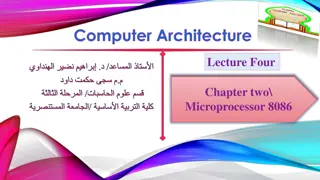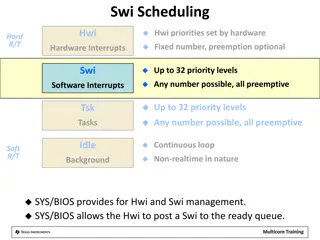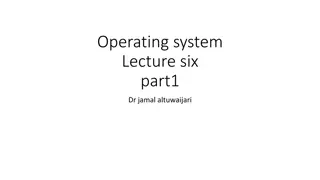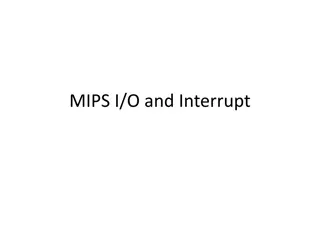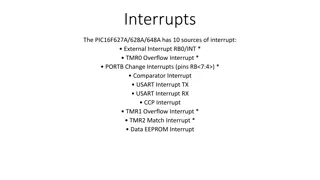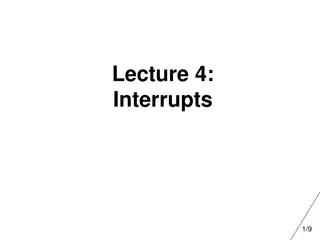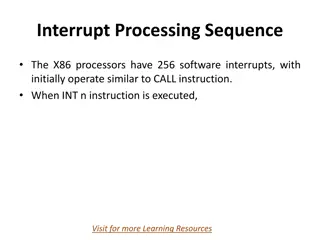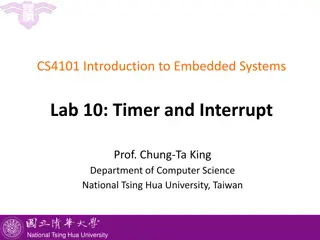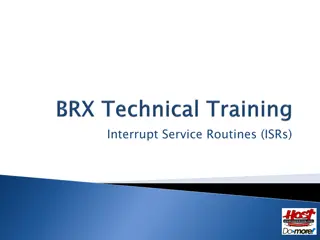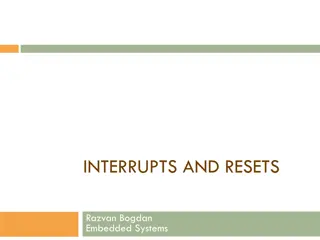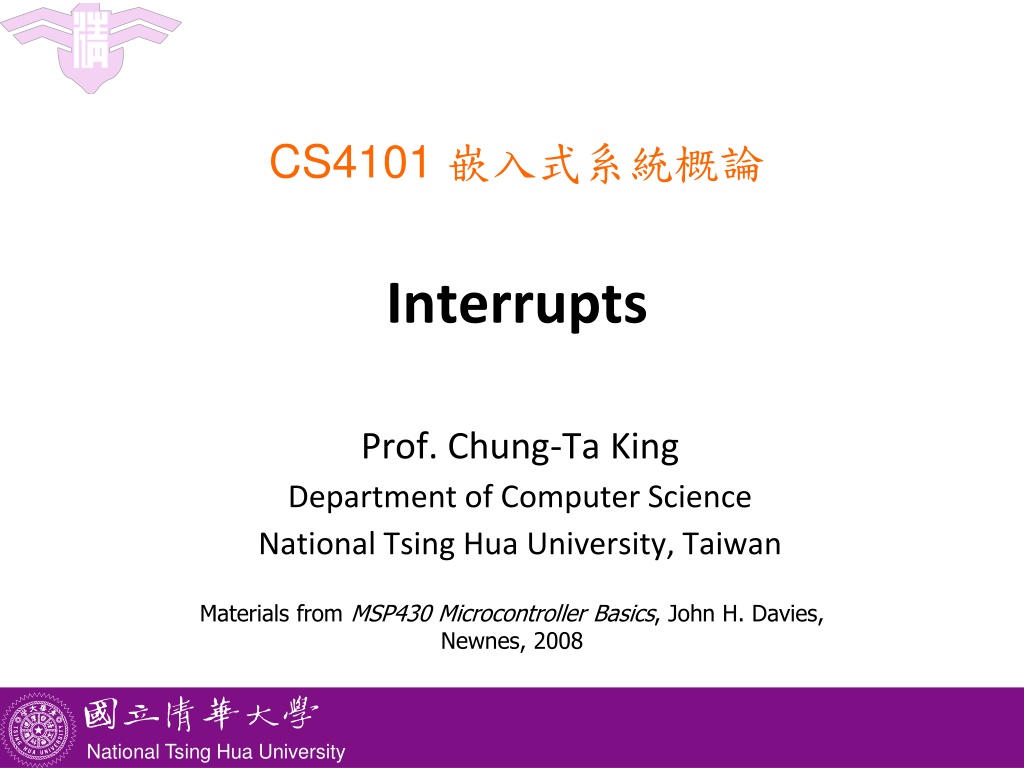
Understanding MSP430 Interrupt Handling
Explore the concept of interrupts in MSP430 microcontrollers, including options for handling external events without disrupting main program flow. Learn about polling versus interrupt-driven approaches and the benefits of utilizing interrupts for efficient event handling.
Download Presentation

Please find below an Image/Link to download the presentation.
The content on the website is provided AS IS for your information and personal use only. It may not be sold, licensed, or shared on other websites without obtaining consent from the author. If you encounter any issues during the download, it is possible that the publisher has removed the file from their server.
You are allowed to download the files provided on this website for personal or commercial use, subject to the condition that they are used lawfully. All files are the property of their respective owners.
The content on the website is provided AS IS for your information and personal use only. It may not be sold, licensed, or shared on other websites without obtaining consent from the author.
E N D
Presentation Transcript
CS4101 Interrupts Prof. Chung-Ta King Department of Computer Science National Tsing Hua University, Taiwan Materials from MSP430 Microcontroller Basics, John H. Davies, Newnes, 2008 National Tsing Hua University
Inside MSP430 (MSP430G2551) 1 National Tsing Hua University
Introduction When MSP430 processor executes the following code, it will loop forever Question: How can it do other things, e.g. handling external events or falling into low-power modes? StopWDT mov.w #WDTPW+WDTHOLD,&WDTCTL SetupP1 bis.b #001h,&P1DIR ; P1.0 output Mainloop xor.b #001h,&P1OUT ; Toggle P1.0 Wait mov.w #050000,R15 ; Delay to R15 L1 dec.w R15 ; Decrement R15 jnz L1 ; Delay over? jmp Mainloop ; Again 2 National Tsing Hua University
Option 1 Put codes that handle external events in your main program polling StopWDT mov.w #WDTPW+WDTHOLD,&WDTCTL SetupP1 bis.b #001h,&P1DIR ; P1.0 output Mainloop xor.b #001h,&P1OUT ; Toggle P1.0 Wait mov.w #050000,R15 ; Delay to R15 L1 dec.w R15 ; Decrement R15 jnz L1 ; Delay over? bit.b #B1,&P2IN ; Test bit B1 jnz ButtonUp ; Jump if not zero ButtonUp:bis.b #LED1,&P2OUT ; Turn LED1 off jmp Mainloop ; Again 3 National Tsing Hua University
Sample Code 1 for Input from Lab 2 #include <msp430.h> #define LED1 BIT0 //P1.0 to red LED #define B1 BIT3 //P1.3 to button void main(void){ WDTCTL = WDTPW + WDTHOLD; //Stop watchdog timer P1OUT |= LED1 + B1; P1DIR = LED1; //Set pin with LED1 to output P1REN = B1; //Set pin to use pull-up resistor for(;;){ //Loop forever if((P1IN & B1) == 0){ //Is button down P1OUT &= ~LED1; } // Turn LED1 off else{ //Is button up P1OUT |= LED1; } // Turn LED1 on } } 4 National Tsing Hua University
Option 2 Keep your program unchanged and force the processor to jump to the code handling the external event when that event occurs Requirements: Must let the processor know when the event occurs Must let the processor know where to jump to execute the handling code Must not allow your program know!! you program must execute as if nothing happens must store and restore your program state This is called interrupt! 5 National Tsing Hua University
Outline Introduction to interrupt The shared-data problem Interrupts of MSP430 6 National Tsing Hua University
Interrupt: Processors Perspective How does the processor know when there is an interrupt? Usually when it receives a signal from one of the IRQ (interrupt request) pins 7 National Tsing Hua University
Interrupt: Processors Perspective What does the processor do in handling an interrupt? When receiving an interrupt signal, the processor stops at the next instruction and saves the address of the next instruction on the stack and jumps to a specific interrupt service routine (ISR) ISR is basically a subroutine to perform operations to handle the interrupt with a RETURN at the end How to be transparent to the running prog.? The processor has to save the state of the program onto the stack and restoring them at the end of ISR 8 National Tsing Hua University
Interrupt Service Routine The following shows an example of an ISR Task Code ... MOVE R1, R7 MUL R1, 5 ADD R1, R2 DIV R1, 2 JCOND ZERO, END SUBTRACT R1, R3 ... ... END: MOVE R7, R1 ... ISR PUSH R1 PUSH R2 ... ;ISR code comes here ... POP R2 POP R1 RETURN ... 9 National Tsing Hua University
Interrupt: Programs Perspective To a running program, an ISR is like a subroutine, but is invoked by the hardware at an unpredictable time Not by the control of the program s logic Subroutine: Program has total control of when to call and jump to a subroutine 10 National Tsing Hua University
Disabling Interrupts Programs may disable interrupts In most cases the program can select which interrupts to disable during critical operations and which to keep enabled by writing corresponding values into a special register Nonmaskable interrupts cannot be disabled and are used to indicate critical events, e.g. power failures Certain processors assign priorities to interrupts, allowing programs to specify a threshold priority so that only interrupts having higher priorities than the threshold are enabled 11 National Tsing Hua University
Where to Put ISR Code? Challenges: Locations of ISRs should be fixed so that the processor can easily find them But, different ISRs may have different lengths hard to track their starting addresses Worse yet, application programs may supply their own ISRs; thus ISR codes may change dynamically Possible solutions: ISR is at a fixed location, e.g., in 8051, the first interrupt pin always causes 8051 to jump to 0x0003 A table in memory contains addresses of ISR the table is called interrupt vector table 12 National Tsing Hua University
How to Know Who Interrupts? Simple answer: according to interrupt signal One interrupt signal corresponds to one ISR Difficult problem: same interrupt signal shared by several devices/events Option 1: inside the corresponding ISR, poll and check these devices/events in turn devices are passive Option 2: devices/events provide the address of ISRs devices are proactive vectored interrupt 13 National Tsing Hua University
Some Common Questions Can a processor be interrupted in the middle of an instruction? Usually not Exceptions: critical hardware failure, long-running instructions (e.g. moving data in memory) If two interrupts occur at the same time, which ISR does the process do first? Prioritize the interrupt signals Can an interrupt signal interrupt another ISR? Interrupt nesting is usually allowed according to priority Some processor may require re-enabling by your ISR 14 National Tsing Hua University
Some Common Questions What happens when an interrupt is signaled while the interrupt is disabled? Processors usually remember the interrupt signals and jump to the ISR when the interrupt is enabled What happens when we forget to re-enable disabled interrupts? What happens if we disable a disabled interrupt? Are interrupts enabled or disabled when the processor first starts up? 15 National Tsing Hua University
Interrupt Latency Interrupt latency is the amount of time taken to respond to an interrupt. It depends on: 1. Longest period during which the interrupt is disabled 2. Time to execute ISRs of higher priority interrupts 3. Time for processor to stop current execution, do the necessary bookkeeping and start executing the ISR 4. Time taken for the ISR to save context and start executing instructions that count as a response Make ISRs short Factors 4 and 2 are controlled by writing efficient code that are not too long Factor 3 depends on HW, not under software control 16 National Tsing Hua University
Sources of Interrupt Overhead Handler execution time Interrupt mechanism overhead Register save/restore Pipeline-related penalties Cache-related penalties 17 National Tsing Hua University
Outline Introduction to interrupt The shared-data problem Interrupts of MSP430 18 National Tsing Hua University
The Shared-Data Problem In many cases the ISRs need to communicate with the task codes through shared variables. Example: Task code monitors 2 temperatures and alarm if they differ An ISR reads temperatures, e.g. on time up 19 National Tsing Hua University
The Shared-Data Problem Now, consider the assembly code: When temperatures are 70 degrees and an interrupt occurs between the two MOVES to read temperatures The temperatures now become 75 degrees On returning from ISR, iTemp[1] will be assigned 75 and an alarm will be set off even though the temperatures were the same 20 National Tsing Hua University
The Shared-Data Problem Problem is due to shared array iTemperatures These bugs are very difficult to find as they occur only when the interrupt occurs in between the first 2 MOVE instructions, other than which the code works perfectly 21 National Tsing Hua University
Solving Shared-Data Problem Disable interrupts during instructions that use the shared variable and re-enabling them later while (TRUE) { disable(); // Disable interrupts iTemp0 = iTemperatures[0]; iTemp1 = iTemperatures[1]; enable(); // Re-enable interrupts ... } 22 National Tsing Hua University
Solving Shared-Data Problem Atomic and Critical Section A part of a program that cannot be interrupted Example: An ISR that updates iHours, iMinutes and iSeconds every second through a hardware timer interrupt: long iSecondsSinceMidnight (void) { long lReturnVal; disable(); lReturnVal = (((iHours*60)+iMinutes)*60)+iSeconds; enable(); return (lReturnVal); } 23 National Tsing Hua University
Outline Introduction to interrupt The shared-data problem Interrupts of MSP430 24 National Tsing Hua University
Know When an Interrupt Occurs An interrupt will be detected and serviced if The global interrupt-enable (GIE) bit in Status Register (SR) in CPU is set A peripheral device enables interrupt For Timer_A: TAIE bit in TACTL register, CCIE bit in TACCTLx register The peripheral signals an interrupt For Timer_A: TAIFG, CCIFG 25 National Tsing Hua University
Ex: Timer_A Interrupt Enabling TACTL TACCTL 26 National Tsing Hua University
When an Interrupt Is Requested Any currently executing instruction is completed. MCLK is started if the CPU was off. The PC, which points to the next instruction, is pushed onto the stack. The SR is pushed onto the stack. The interrupt with the highest priority is selected. The interrupt request flag is cleared automatically for vectors that have a single source. The SR is cleared, and maskable interrupts are disabled. The interrupt vector is loaded into the PC and the CPU starts to execute the ISR at that address. These operations take about 6 cycles 27 National Tsing Hua University
After an Interrupt Is Serviced An interrupt service routine must always finish with the return from interrupt instruction reti: The SR pops from the stack. All previous settings of GIE and the mode control bits are now in effect. enable maskable interrupts and restores the previous low-power mode if there was one. The PC pops from the stack and execution resumes at the point where it was interrupted. Alternatively, the CPU stops and the device reverts to its low-power mode before the interrupt. 28 National Tsing Hua University
Where to Find ISRs? The MSP430 uses vectored interrupts. Each ISR has its own vector, which is stored at a predefined address in a vector table at the end of the program memory (addresses 0xFFC0 0xFFFF). The vector table is at a fixed location, but the ISRs themselves can be located anywhere in memory. 29 National Tsing Hua University
System Interrupt Word Address Interrupt Source Interrupt Flag Priority Power-up/external reset/Watchdog Timer+/flash key viol./PC out-of-range NMI/Oscillator Fault/ Flash access viol. PORIFG RSTIFG WDTIFG KEYV NMIIFG/OFIFG/ ACCVIFG 31 Reset 0FFFEh (highest) Non-maskable 0FFFCh 30 0FFFAh 0FFF8h 0FFF6h 0FFF4h 0FFF2h 0FFF0h 0FFEEh 0FFECh 0FFEAh 0FFE8h 29 28 27 26 25 24 23 22 21 20 Watchdog Timer+ Timer_A2 Timer_A2 WDTIFG TACCR0 CCIFG TACCR1 CCIFG, TAIFG maskable maskable maskable ADC10 USI ADC10IFG USIIFG USISTTIFG maskable maskable I/O Port P2 (2) P2IFG.6, P2IFG.7 maskable 0FFE6h 19 I/O Port P1 (8) P1IFG.0 to P1IFG.7 maskable 0FFE4h 0FFE2h 0FFE0h 0FFDEh 0FFCDh 18 17 16 Unused 15 - 0 30 National Tsing Hua University
Sample Code Toggle LEDs using interrupts from Timer_A in up mode #include <io430x11x1.h> // Specific device #include <intrinsics.h> // Intrinsic functions #define LED1 BIT0 #define LED2 BIT4 void main (void) { WDTCTL = WDTPW|WDTHOLD; // Stop watchdog timer P1OUT = LED1; P1DIR = LED1; TACCR0 = 49999; // Upper limit of count for TAR TACCTL0 = CCIE; // Enable interrupts TACTL = MC_1|ID_3|TASSEL_2|TACLR; // Up mode, divide clock by 8, clock from SMCLK, clear __enable _interrupt(); // Enable interrupts (intrinsic) for (;;) { // Loop forever doing nothing } } // Interrupt service routine for Timer_A #pragma vector = TIMERA0_VECTOR __interrupt void TA0_ISR (void){ P2OUT = LED1|LED2; // Toggle LEDs } 31 National Tsing Hua University
Summary Interrupts: a subroutine generated by the hardware at an unpredictable time Issues to consider: How to set up and know there is an interrupt? How to know where is the interrupt service routine? Must not interfere the original program The shared-data problem MSP430 interrupt mechanism 32 National Tsing Hua University


